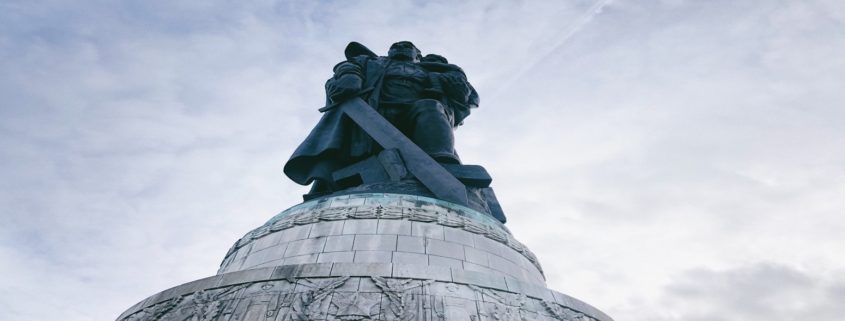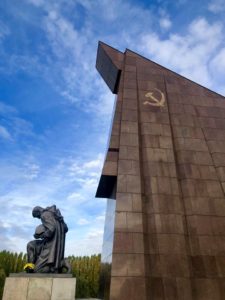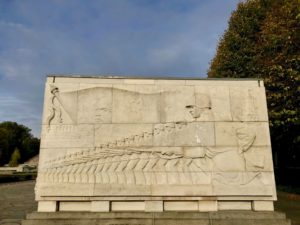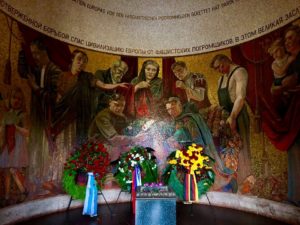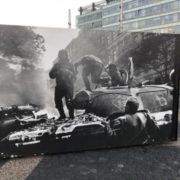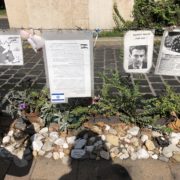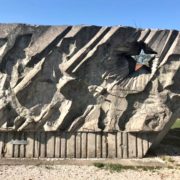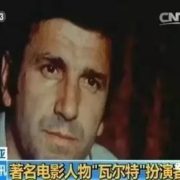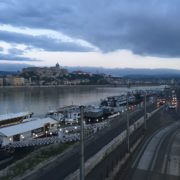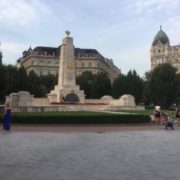Suffering for Freedom: Socialist Realism in Memorialization
By Taylor Krzeminski
“Herein lies the strength of the Red Army. And herein lies the
weakness of the German fascist army.” – Josef Stalin
The capital of a former fascist and communist state, a city of destruction and liberation – Berlin occupies a special place in memorial culture. At the Treptower Park Soviet Memorial, historical memorialization intertwines with politics, past suffering lives with red pride; all standing through the lens of socialist realism. Art plays a crucial role in the remembrance and memorialization of trauma and past. Yet, art is not immune to politics, emotions or manipulation. Erected to commemorate the 80,000 Soviet lives lost during the Battle of Berlin in 1945, the park stands as a reminder of the past and a warning for the future; also, a reflection on the implications of the Soviet victory on memorial culture.
On June 22, 1941, Nazi Germany invaded the Soviet Union, starting the “Great Patriotic War.” Battles taking place on the Eastern front were the largest military confrontation in history, resulting in utter destruction of both land and life. The Eastern front was also central to the Holocaust – almost all killing sites, extermination camps and ghettos were located here. An estimated 30 million people died on the Eastern front, twenty-million of which is attributed to Soviet soldiers and civilians. As the Soviet Union advanced west toward Berlin in the spring of 1945, the road to victory began. An estimated 80,000 Red Army soldiers perished in the battle for Berlin. As many as 8,000 rest in the Treptower Park.
“Eternal glory to the heroes who fell for the liberty and independence of the socialist homeland,” reads the gated entrance to the Treptower, in both German and Russian. Visitors are greeted ominously by weeping willows, which engulf a statue of a woman crying over the fallen before her. A common symbol in socialist realism of the motherland, the woman represents the Soviet Union mourning the loss of soldiers and citizens. Parallel to the statue a path leads to two large Soviet flag reconstructions made of rustic red granite, each flanked by a kneeling Red Army soldier. Before beauty, they say there must be pain. This entrance to the breath-taking geometric garden of the Treptower fills visitors with only a small amount of the agony felt by Soviets during the Great Patriotic War.
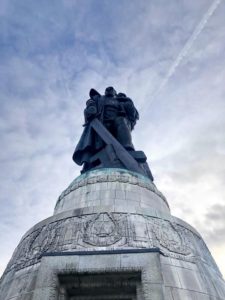
Depiction of the USSR’s Liberation of Germany from fascism, reflected in socialist realist statues across the former communist states.
Leading up to the Soviet liberation statue, there are 16 gravestones each of which represents a Soviet Republic and its contribution to the fight against fascism. The socialist realist artwork etched into the stone details the progression of the war from 1941 to 1945. Many at first show the invasion of the Eastern Front and the slaughter of the Soviets; people running from bombings, destruction of cities. As we progress through the war, we see the rise of communism against fascism: men, women, workers, and soldiers join together to liberate their country. They join hands, hold weapons high in the air. One stone depicts Soviet soldiers lined up for battle in Moscow, with Lenin’s face watching over them. In this particular stone we are able to see a theme that resonates throughout the park, that sacrifice is inevitable, but so is the fall of the Third Reich. This vision is realized at the heart of the park.
Past the Soviet suffering, parallel to the weeping motherland, looms a Soviet soldier holding a lowered sword. In the other hand, he holds a small child; beneath his boot, we see the remains of a broken
swastika. Even from afar, the statue immediately captures one’s eye, demanding attention. This highlights one of the most important themes within the Treptower: that the sacrifices were worth it. The statue reflects the brutal price paid by the Soviet Union in the fight against Nazi Germany. Yet, we have gained liberation, a world free from “fascist thugs,” as Stalin’s quote in the park declares. The juxtaposition of the soldier and the weeping motherland highlights liberation – while she mourns the fallen Soviets, it is they who saved the world from the Nazis. With the child held in his hand, and standing on the tomb of the fallen soldiers, the statue of the Soviet soldier symbolizes the future the Soviet Union will create. We must mourn the loss of those brave soldiers that sacrificed their lives, but there should be no worry, as the Communist future is here.
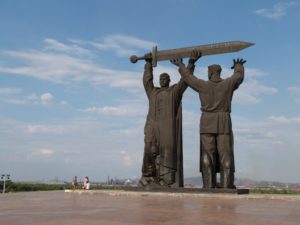
Rear-front memorial: A Steelworker is passing a sword to a Soviet soldier – , which is a part of the story told through Soviet socialist realism sculptures. The soldier in Treptow is crushing Nazism with this sword. Photograph by Arthur House, http://www.calvertjournal.com/articles/show/1332/magnetic-mountain-magnitogorsk.
The statues in Treptower tell a story, one that goes beyond the physical space of the park and is a part of the Soviet narrative of World War II. The symbolism depicted through socialist realism here is connected strongly to two other statues in Russia. In what was previously called Stalingrad, there is a statue of a woman reaching behind her and raising a sword forward. She represents the motherland, calling on its people to fight against the Nazis. In Magnitogorsk, the statue of two giant men stand over a cliff, but their gaze is not fixed on the physical view. Instead they look toward a battle. A steelworker raises a sword above his head, a soldier grabbing it to take into battle against Nazi Germany. It is our duty to the motherland to go into battle, and the war effort is more than just soldiers. Without workers, soldiers would not be prepared on the Eastern Front. This story ends in the Treptower park, with the mourning of 20 million dead, but with a socialist future ahead.
The relationship between Germany and Russia has always been difficult and remains so today. So why does a memorial like this still stand so proudly in the heart of Germany? Without the Red Army, Nazi victory very well could have happened and the Europe we know today would have been a very different place. Germany, regardless of its contemporary perception of Russia, recognizes that the monumental Soviet sacrifice deserves memorialization. The Treptower Park offers us a case study of socialist realism, and how Soviet victory is depicted through memorial culture. While the art we see in this park is a form of the Soviet narrative, the emotion the space evokes from visitors is genuine. Looking up at the giant statues, I could feel myself becoming incredibly prideful even though I am not Russian, and my family was never part of the Red Army. While there may be problems with socialist realism and its function as a propaganda, what we see here in Treptower is that socialist realism can be used to tell a true story, one of the suffering of millions under Nazi German occupation and the struggle against it.

